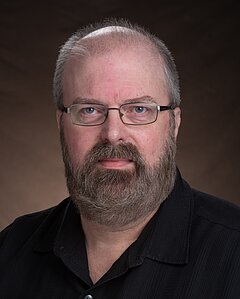Seth C. Rasmussen
Professor
Research Interest(s):
Materials Research
Our research focuses on the synthesis and characterization of novel conjugated organic materials, as well as their application to organic photovoltaics (OPVs or solar cells), NIR photodetectors, and organic light emitting diodes (OLEDs). Conjugated organic materials are of considerable fundamental and technological interest as they exhibit the unique combination of the optical and electronic properties of inorganic semiconductors with the weight, flexibility, and processability of organic plastics. As a result, the application of these materials has led the way to the development of the current field of organic electronics, with modern technological applications including the previously mentioned OPV devices, NIR photodetectors, and OLEDs, as well as organic field effect transistors (OFETs), electrochromic devices , and a variety of sensors.
The efforts of the Rasmussen group currently focus on the preparation and study of polythiophene-based organic materials as potential low band gap (Eg < 1.0 eV) and reduced band gap (Eg = 1.5-2.0 eV) materials. These materials are based on several heterocyclic building blocks developed by the group, including thieno[3,4-b]pyrazines (TPs), acenaphtho[1,2-b]thieno[3,4-e]pyrazines (ATPs), dithieno[3,2-b:2',3'-d]pyrroles (DTPs), and pyrrolo[3,2-d:4,5-d']bisthiazoles (PBTzs). Additional hybrid building blocks include metal thiophenedithiolene (MTDT) or thiazoledithiolene (MTzDT) complexes. Such efforts have resulted in conjugated materials with record low band gaps (as low as 0.45 eV), record high emission efficiencies (up to 92%), and photovoltaic responses to both far red and NIR wavelengths.
These efforts combine synthetic inorganic and organic chemistries for the production of new materials, along with the structural, electronic, and optical characterization of these materials via various physical and analytical methods. In addition, the Rasmussen group collaborates with researchers worldwide in the application of materials developed at NDSU to generate working NIR photodetectors, photovoltaic devices, and OLEDs. As such, students working on these projects gain experience in organic, inorganic, and polymer synthesis, as well as additional experience with a variety of spectroscopic, electrochemical, crystallographic, and computational techniques. Via various collaborations, students can also gain experience with hands-on device fabrication.
Chemical History
Prof. Rasmussen's scholarly efforts in the history of chemistry began with applications of history to science education, but have developed over the last 20+ years to focus primarily on the history of materials (silicate glasses, organic polymers/plastics, metals, etc.). This has led to recognition as both a leader in the history of silicate glasses from antiquity to the 18th century and the leading expert on the history of conjugated/conducting polymers. This work has led to the publication of eight books on the history of chemistry and a wealth of book chapters and journal articles. While Prof. Rasmussen does not supervise students for graduate degrees in history, opportunities for supplementary history projects are available for interested students.
External Links:



